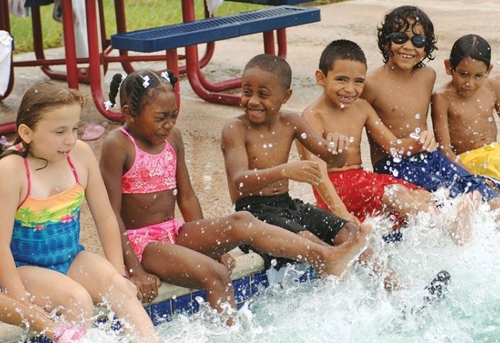
Children playing at the swimming pool used to illustrate the story (Photo: Black Kids Swim)
Children need constant supervision around water, be it a bathtub, a
wading pool, an ornamental fish pond, a swimming pool, a spa, the
beach, or a lake.
Swimpro, a platform that connects personal swimming instructors to
learners across Nigeria, says young children are especially at risk
because they can drown in less than two inches (6 centimeters) of water.
That means drowning can happen where you would least expect such as
the sink, the toilet bowl, fountains, buckets, inflatable pools.
In addition, small bodies of standing water around your home, such
as ditches filled with rainwater also pose great risks to children. This
is why it is always best to watch children closely when they are in or
near any water.
The following eight life-saving water tips for children will be useful if you are a parent, guardian or caregiver.
1- Learn how to swim
If you’re not a swimmer yourself, it’s a good idea to take lessons
and learn how to swim. (Check the local recreation center for classes
taught by qualified instructors).
Never take your eyes off your child when he or she is in or around
the water. Children who are younger (but older than age 1) might also
benefit from swimming lessons, but check with your doctor first.
2- Have a fence around the pool
Having a pool, pond, spa, or hot tub on your property is a tremendous responsibility when it comes to safety.
Swimpro says hot tubs may feel great to adults, but kids can become
dangerously overheated in them and can even drown. So, it’s best not to
let them use them at all. Having a fence (one that goes directly around
the pool or spa) between the water and your house is the best safety
investment you can make and will help prevent pool-related drowning.
3- Fences should be at least, four feet
According to the Consumer Product Safety Commission (CPSC), fences
should meet these standards: Fences should stand at least four feet (130
centimeters) high with no foot or handrails for kids to climb on. The
slats should be less than four inches (110 millimeters) apart so a child
can’t get through, or if chain link, should have no opening larger than
one and three quarter inches (50 millimeters). Gates should be
self-closing and self-latching, and the latch should be out of kids’
reach.
4- Buy other pool devices
You can buy other devices, such as pool covers and alarms, but
these haven’t been proved effective against drowning for very young
children, so fencing remains your best measure of protection.
5- Kids need constant supervision
All kids need to be supervised in the water, no matter what their swimming skills.
Infants, toddlers, and weak swimmers should have an adult swimmer within arm’s reach to provide “touch supervision.”
6-Ignore your phone
Make a pact with yourself: When you’re at the pool or the beach or
the lake, silence your phone and stow it out of reach in your bag so
you’re not tempted to use it. “If you hear a text message come in and
turn to your phone for five seconds, that’s long enough for a child to
be submerged,” says Anne Beasley, M.D., a pediatric hospitalist at
Phoenix Children’s Hospital.
7-Teach your child the rules
For easy memorizing, stick to these five: no running, no diving in
the shallow end, no pushing people in, no pulling other kids under the
water, and no swimming without adult supervision ever. And remember:
Children aren’t the only ones who shouldn’t swim alone; it’s not
particularly safe for adults to swim solo either, says Dr. Callahan of
parents.com
8-Learn CPR
If the worst happens and you have to rescue a distressed swimmer,
conducting CPR while you wait for an ambulance to arrive could save that
person’s life. When the heart stops, continuing to circulate blood to
the brain helps prevent a bad outcome.
In a perfect world, all parents would be trained in CPR. If you’re
untrained or rusty on CPR, do chest compressions (100 per minute), and
skip rescue breathing, also known as mouth-to-mouth. When it comes to
drowning, doing something is always better than doing nothing.
**********
Sources: Swimpro / PREMIUM Times / Parents.com





















0 comments:
Post a Comment